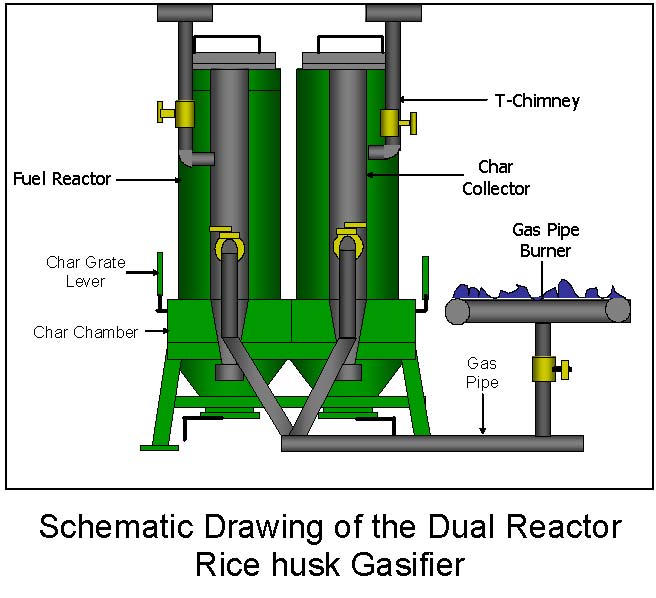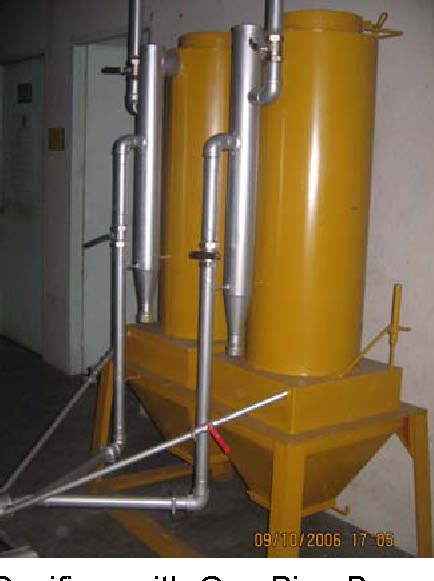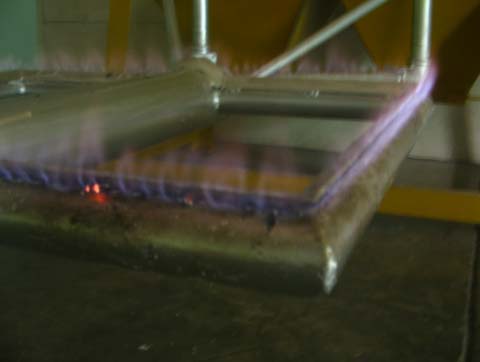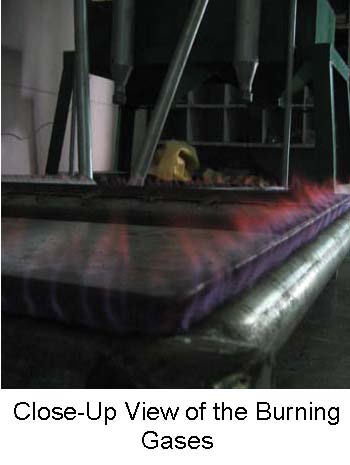Dual Reactor Rice Husk Gasifier with Gas Pipe Burner
Alexis Belonio, Central Philippines University, October 22, 2006
Note: Click images to enlarge.
Fuelling LPG oven with biomass fuel is quite difficult to achieve. With the dual reactor rice husk gasifier, however, LPG oven can now be retrofitted with gas burner using biomass rice husk as fuel. This technology was developed at the Department of Agricultural Engineering and Environmental Management, College of Agriculture, Central Philippine University, Iloilo City, Philippines. Test runs on the performance of this rice husk gasifier were conducted with the assistance from the following agricultural engineering students Jason Gem Villaruel, Lucio Larano, Daniel Belonio, Yvone Herbo, and Jeffrey Cocjin . The rice husk gasifier adopts two top-lit updraft (t-lud) type reactors so as to allow continuous supply of combustible gases into the gas-pipe burner that is suitable for LPG bakery ovens.
Each reactor, right photos, has a diameter of 0.25 m and a height of 1.05 m. It is here in the reactor where rice husk is gasified by burning it with limited amount of air (equivalence ratio = 0.27). In order to prevent the heat from radiating from the reactor, a 5-cm rice husk ash insulation was provided between the inner and the outer cylinders. Beneath the reactor is a char chamber to hold burnt rice husk discharged after each operation. A flat grate made of 6-mm diameter plain round bar, with ¼-in. spacing, is used to hold rice husk during operation. This grate can be released manually to discharge the char from the reactor. A 2-in. diameter electric blower is used to push the ambient air into the fuel bed to gasify rice husks at a rate of 34.4 m3 per hour. The reactor is provided with a lid to facilitate loading and igniting of fuel. The gas produced during gasification is diverted out of the reactor through a cylindrical-momentum type separator that is made of 3-inch GI pipe. A 1¼-in. diameter chimney is used to divert unwanted gases at the initial stage of firing the fuel. When quality gas is produced, it is diverted out to a 1-1/4 in. diameter gas-pipe burner for subsequent burning. The gas burner is made of GI pipe with series of 3/16-in. holes spaced at ¼ in.
Performance tests of the gasifier were carried out thru series of runs using freshly obtained rice husk from a rice mill. The weight of rice husk fuel and of char was recorded using a 10-kg spring scale. The temperature of the gas leaving the reactor and the gas entering the gas-pipe burner were taken using a type K thermocouple wire thermometer. The pressure draft in the fuel bed inside the reactor was also measured during the tests using a U-tube manometer.
Results showed that firing of rice husk fuel can be easily done and spontaneous combustion is achieved within a minute. Each reactor contains an average of 4.96 kg of rice husk per load and produces a char of 1.25 kg after each operation. Tests also showed that a fully loaded reactor with rice husk fuel can be operated within 29.50 minutes with specific draft of 25.73 mm of water per meter depth of fuel . The computed rice husk consumption is 10.18 kg per hour while the specific gasification rate is 191.77 kg/m2-hr. The rate of movement of the fire zone is 3.42 cm/min with superficial gas velocity of 5.41 cm/sec. The temperature of gas leaving the reactor varies from 270 to 320ºC. The gas enters the gas-pipe burner at a temperature of 152 to 170ºC. The thermal efficiency of the gasifier, based on the amount of combustible gases produced from the burner and the fuel used, is 41.11%. The computed power output of the gasifier is 14.89 kW. The gas burner was found to have satisfactory performance producing a bluish to pinkish flame color at a gas velocity of 1.22 meter per second. The power input of the electric blower is 0.04 kW-hour.
The reactors are operated in sequential mode to provide a continuous supply of combustible gases into the gas-pipe burner. In order to attain uninterrupted operation, the second reactor must be ready at least 3 minutes before the fuel in first reactor is fully consumed. One person is needed to attend the operation of the gasifier for sequential loading of rice husk and unloading of char.
The total cost to produce the gasifier at current prices is P35,000.00. Production period takes at least 2 weeks employing two skilled workers. When used in a 24-plate bakery oven, the computed payback period is less than one year compared with LPG fuel.
Based on the results of the study the following are concluded and recommended:
(a) The gasifier is a simple and a low-cost technology that can be effectively used as replacement for LPG fuel;
(b) It can be fabricated in a small fabricating shop using local materials;
(c) The gas produced from the gasifier can be successfully burned in a gas-pipe burner and is suitable for use in an LPG-type bakery oven; and
(d) There is a need to consider the kind of materials to be used for the inner cylinder of the reactor to prolong its useful life.
Inquiry regarding this technology can be coursed through the Project Director, Appropriate Technology Center, Department of Agricultural Engineering, Environmental Management, College of Agriculture, Central Philippine University, Iloilo City, Philippines. You may contact us through phone (063-033-3291971 loc 1071) and/or email (cpu_aprotech@yahoo.com).
1 US$ = 55 PHP









